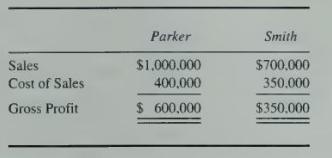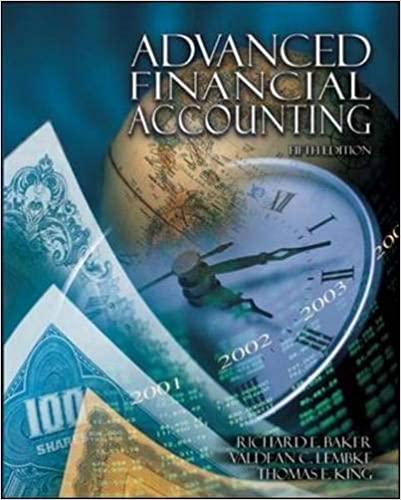Select the correct answer for each of the following questions. 1. Perez Inc. owns 80 percent of
Question:
Select the correct answer for each of the following questions.
1. Perez Inc. owns 80 percent of Senior Inc. During 20X2, Perez sold goods with a 40 percent gross profit to Senior. Senior sold all of these goods in 20X2. For 20X2 consolidated financial statements, how should the summation of Perez and Senior income statement items be adjusted?
a. Sales and cost of goods sold should be reduced by the intercompany sales.
b. Sales and cost of goods sold should be reduced by 80 percent of the intercompany sales.
c. Net income should be reduced by 80 percent of the gross profit on intercompany sales.
d. No adjustment is necessary.
2. Parker Corporation owns 80 percent of Smith Inc.'s common stock. During 20X1, Parker sold Smith \(\$ 250,000\) of inventory on the same terms as sales made to third parties. Smith sold all of the inventory purchased from Parker in 20X1. The following information pertains to Smith and Parker's sales for 20X1:

What amount should Parker report as cost of sales in its 20X1 consolidated income statement?
a. \(\$ 750,000\).
b. \(\$ 680,000\).
c. \(\$ 500,000\).
d. \(\$ 430,000\).
Items 3 and 4 are based on the following information:
Nolan owns 100 percent of the capital stock of both Twill Corporation and Webb Corporation. Twill purchases merchandise inventory from Webb at 140 percent of Webb's cost. During 20X0, merchandise that cost Webb \(\$ 40,000\) was sold to Twill. Twill sold all of this merchandise to unrelated customers for \(\$ 81,200\) during 20X0. In preparing combined financial statements for 20X0, Nolan's bookkeeper disregarded the common ownership of Twill and Webb.
3. What amount should be eliminated from cost of goods sold in the combined income statement for \(20 \times 0\) ?
a. \(\$ 56,000\).
b. \(\$ 40,000\).
c. \(\$ 24,000\).
d. \(\$ 16,000\).
4. By what amount was unadjusted revenue overstated in the combined income statement for 20X0?
a. \(\$ 16,000\).
b. \(\$ 40,000\).
c. \(\$ 56,000\).
d. \(\$ 81,200\).
5. Clark Company had the following transactions with affiliated parties during 20X2:
- Sales of \(\$ 60,000\) to Dean Inc., with \(\$ 20,000\) gross profit. Dean had \(\$ 15,000\) of this inventory on hand at year-end. Clark owns a 15 percent interest in Dean and does not exert significant influence.
- Purchases of raw materials totaling \(\$ 240,000\) from Kent Corporation, a wholly owned subsidiary. Kent's gross profit on the sale was \(\$ 48,000\). Clark had \(\$ 60,000\) of this inventory remaining on December 31, \(20 \mathrm{X} 2\).
Before eliminating entries, Clark had consolidated current assets of \(\$ 320,000\). What amount should Clark report in its December 31, 20X2, consolidated balance sheet for current assets?
a. \(\$ 320,000\).
b. \(\$ 317,000\).
c. \(\$ 308,000\).
d. \(\$ 303,000\).
6. Selected data for two subsidiaries of Dunn Corporation taken from the December 31, 20X8, preclosing trial balances are as follows:

Additional data relating to the December \(31,20 \times 8\), inventory are as follows:
At December 31,20X8, the inventory reported on the combined balance sheet of the two subsidiaries should be:
a. \(\$ 425,000\).
b. \(\$ 435,000\).
c. \(\$ 470,000\).
d. \(\$ 485,000\).
Step by Step Answer:

Advanced Financial Accounting
ISBN: 9780072444124
5th Edition
Authors: Richard E. Baker, Valdean C. Lembke, Thomas E. King





